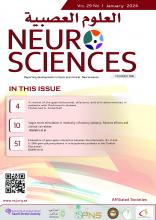To the Editor
We have read with interest the article by Khashab et al1 who reported a retrospective cohort study of 22 patients with radicular pain without improvement of pain over a period of 6 months with appropriate conservative treatment who underwent hydrodiscectomy during a observational period of 5 years.1 A reduction or complete elimination of radicular pain was achieved in 68% of patients and 96% tolerated the procedure without pre-, intra- or post-operative complications.1 It was concluded that percutaneous hydrodiscectomy is safe and effective in patients with chronic, refractory radicular lumbar pain.1 The study is excellent but raises concerns that should be discussed.
The major limitation of the study is the retrospective, single-centre, and uncontrolled design. In addition, the number of patients included was small. In order to achieve the goals of the study and draw reliable conclusions, it is imperative to examine a significantly larger group prospectively and in a multicentre manner and to compare the hydrodiscectomy participants with an age and gender-matched control group. Unless such a design is used, the present conclusions from the study are unreliable.
Another limitation that there is no mention whether alternative causes of radicular pain have been sufficiently ruled out or not. It is simply stated that patient with vertebrostenosis were excluded from the study. However, lower back pain in a patient with disc bulging may be due to more than just bulging. We should know whether alternative causes of lower back pain, such as scoliosis, listhesis, chondrosis, osteochondrosis, spondylosis, spondylarthrosis, uncovertebral arthrosis, foramen stenosis, radiculitis, syringomyelia, varicositas spinalis, spinal infarction, and Borelliosis, have been sufficiently ruled out.
There is a discrepancy between the statement that “none of the patients required further interventions at the 12 months follow-up” and the results that mention that 41% experienced only a reduction of pain after hydrodiscectomy, while 5 patients experienced no change of symptoms, and that pain increased after hydrodiscectomy in 2 patients. This discrepancy should be resolved. What type of treatment was given to patients in whom the effect of the procedure was an insufficient to achieve complete relief?
Another limitation of the study is that factors that influence disc bulging, such as hydration, level of physical activity and exercise, and time of day, were not included in the analysis. A bulging disc is usually not an indication for discectomy. When pain is refractory in patients with mono-or mulita-segmental bulging, it is imperative not only to rule out all different causes, but also to consider burnout, chronic stress, overwork, depression, or anxiety disorder. The use of suitable questionnaires or tests would have been mandatory in this context.
Have all available conservative therapies including electrostimulation and CT-targeted infiltration been carried out?
Overall, the interesting study has limitations that call into question the results and their interpretation. Clarifying these weaknesses would strengthen the conclusions and could add value to the study. Before performing hydro-discectomy in patients with chronic radicular lumbar pain, all differential causes of lumbar pain must be sufficiently ruled out.
Reply from the Author
We thank Prof. Josef Finsterer for his concerns and comments expressed in his letter to the editor on the article Percutaneous hydrodiscectomy surgery effectiveness in chronic back pain. The authors considered the outcome of hydrodiscectomy in a cohort of 22 patients that underwent hydrodiscectomy procedure at one level after a period of at least 6 months since the commencement of the symptoms and after the patients have received conservative management and were referred for surgical intervention. We would like to thank Prof. Finsterer for describing the study as excellent. We acknowledge the limitations of the study; a retrospective uncontrolled design, single center, and the limited number of patients. This is mentioned at the end of the discussion part of the article body.
This study had a very strict inclusion/exclusion criteria, as mentioned in methodology section in the body of the article. This might also explain the small number of the cohort. All other reasons apart from a herniated disc were excluded from the study cohort and all the areas of the spine apart from the lumbar area were excluded. Causes such as central stenosis, spondylolisthesis and bone impingement were excluded. Uncovertebral arthrosis was also excluded being a condition that affects the cervical spine which is an area excluded from the study population.
Before referring the patients to our service for surgical intervention they underwent a full conservative program including and not limited to physiotherapy, ultrasound therapy, electrical stimulation, image guided injections …etc.
The patients who required no further intervention in the 12 months following the intervention are the patients who experienced full or major relief of their symptoms (68%), this is explained in the discussion part of our article body, the remaining patients who experienced no improvement or worsening of symptoms were channeled to the appropriate management measures.
The authors acknowledge that burnout, chronic stress, overwork depression and anxiety disorder were not considered in this study.
The authors acknowledge that this study is but a small step to shed a light on such a technique utilized for chronic back pain and further larger cohorts, multicentral and controlled studies are recommended.
- Copyright: © Neurosciences
Neurosciences is an Open Access journal and articles published are distributed under the terms of the Creative Commons Attribution-NonCommercial License (CC BY-NC). Readers may copy, distribute, and display the work for non-commercial purposes with the proper citation of the original work.
References
- 1.↵






